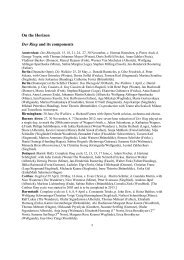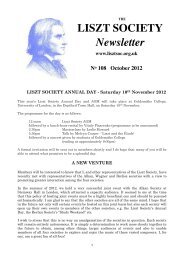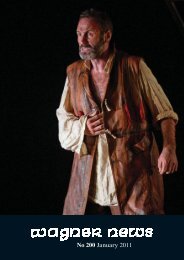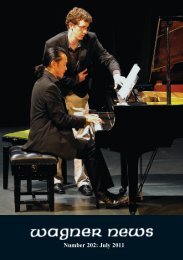Number 201: APRIL 2011 - Wagner Society of England
Number 201: APRIL 2011 - Wagner Society of England
Number 201: APRIL 2011 - Wagner Society of England
Create successful ePaper yourself
Turn your PDF publications into a flip-book with our unique Google optimized e-Paper software.
In Act III, as Parsifal says, everything is altered. A huge section has been cut out <strong>of</strong><br />
the floor and back wall, leaving a gaping black void from which a railway line, supported at<br />
its rear on girders, extends to the front <strong>of</strong> the stage on the right-hand side. The tracks and<br />
sleepers are broken at the end and shattered pieces lie about. Monsalvat is, literally as well<br />
as figuratively, at the end <strong>of</strong> the line, and Kundry, covered in white draperies, lies at its<br />
terminus.<br />
A pit to the left <strong>of</strong> the stage contains several figures from the Terracotta Army, some<br />
broken, stacked like toy soldiers in a box. One wonders whether they are Knights who have<br />
turned to stone because the Grail was denied to them. Gurnemanz sits watching them like a<br />
guardian <strong>of</strong> the dead, a huge robe draped over him so that he, too, resembles a statue. When<br />
he first hears Kundry’s groan he does not stir, as though any movement is too much effort<br />
after sitting immobile for so long. When she cries out again he rises, goes to her, and does<br />
his best to revive her, but her position between the tracks makes it awkward for him to reach<br />
her. She lurches to her knees with a shriek. She now wears a crumpled white gown with a<br />
long train and is swathed in layers <strong>of</strong> white drapery, almost as though she were a mummy.<br />
Her dangerous beauty is gone, and her plain face is serene. She wears a close-fitting cap from<br />
beneath which pure white hair cascades to her waist. Gurnemanz, <strong>of</strong> course, grumbles at her<br />
lack <strong>of</strong> thanks for restoring her to life, but does not realise how the need to help her has<br />
brought him back to life too.<br />
Parsifal enters, walking slowly along the railway track, carrying the Spear and<br />
wearing elaborate black armour. He is utterly exhausted, and when he at last removes his<br />
helmet, his pale face is lined with care and his eyes are heavily shadowed. Whatever he has<br />
undergone since leaving Klingsor’s domain, it has marked him irrevocably. Even the<br />
knowledge that he has reached his goal brings him little relief. His relationship with Kundry<br />
is developed most beautifully in this scene, as one senses her bringing him, too, back to life.<br />
She prostrates herself before him when Gurnemanz anoints him as King, is utterly astonished<br />
when he baptises her, and sinks to the ground, sobbing, then rises and comes forward, her<br />
arms spread wide in rapture, her pale face radiant. One feels the sense <strong>of</strong> release flooding<br />
through her. She sits at the front <strong>of</strong> the tracks and during Gurnemanz’s Good Friday solo<br />
Parsifal approaches her and takes her tenderly in his arms, resting her head upon his shoulder,<br />
almost as though she were a child. There is a sense <strong>of</strong> the absolute love and trust between<br />
them.<br />
The bells sound and Gurnemanz leads Parsifal and Kundry away, down into the black<br />
void beneath the railway line. For some time the stage is left empty, then Amfortas stumbles<br />
in along the track. He takes refuge in the pit containing the statues from which he lifts the<br />
tiny, shrivelled form <strong>of</strong> the dead Titurel. The voices <strong>of</strong> the chorus sound somewhere in the<br />
void before they begin to emerge from the darkness and struggle up the steps onto the stage.<br />
They are now dressed as soldiers from the First World War, wearing long grey coats which<br />
echo their Act I costumes, with knapsacks, equipment belts and helmets with gas masks. It<br />
is like watching John Singer Sargent’s painting, “Gassed”, coming to life. A seemingly<br />
endless tide <strong>of</strong> wrecked, shattered humanity pours onto the stage while the music tolls out<br />
remorselessly. Their cries <strong>of</strong> “Just one last time!” still haunt me. It is shattering.<br />
Through their sufferings, the Knights have become human again, but their selfish<br />
persecution <strong>of</strong> Amfortas remains unchanged. While he laments over his father they stand, sit<br />
or lie in ragged groups around the stage, their former rigid discipline forgotten, either<br />
ignoring him or watching with increasing impatience until, as before, they turn on him in a<br />
solid mass, pinning him into the centre <strong>of</strong> the group. Some have their backs towards the<br />
– 24 –










